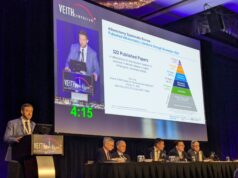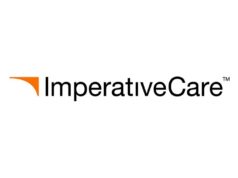
It is important to use the right embolic agent for the job – an embolic agent that is particularly suitable for one indication may not at all be appropriate for another. Robert Morgan, vascular interventional radiologist, St Georges Hospital, London, UK, tells Interventional News why he uses liquid embolic agents, such as ethylene vinyl oxide copolymer (EVOH-based) liquid agents, of which Onyx (Medtronic) is an example, for endoleak embolization.
Some potential advantages that liquid embolics offer in endoleak embolization are that they enable more rapid and complete filling of the endoleak cavity when compared with coils. They can also represent a less expensive option in situations where otherwise multiple coils would be needed.
Morgan makes the point that liquid embolic agents are particularly suitable for endoleak embolization because they can be used “to fill the cavity”. Other embolic agents such as coils have been used for endoleak embolization (although they are unsuitable for large cavities) and particles are completely unsuitable for endoleak embolization, he notes. He also clarifies that he would use embolization with particles mainly for small vessel embolization, such as uterine fibroid embolization, and embolization with coils mainly for the embolization of haemorrhage.
Commenting on some of the difficulties of using liquid embolic agents, Morgan makes the point that there are mainly two types of liquid embolic agents: “The cyanoacrylate adhesives (or glue-type embolics) and the EVOH-based agents (or Onyx-type embolics).”
While glue is relatively inexpensive in Europe, it polymerises in ionic fluids (such as blood) and is used with a non-ionic solvent such as dextrose to stop the glue polymerising in the catheter. “This is why there is a need to inject glue and withdraw the catheter, to prevent the catheter sticking to the glue, which makes it a more difficult embolic for endoleaks. On the other hand, Onyx is easier to use and fills the cavity without adhering to the catheter, so you can inject it and then leave the catheter there until the end, but is more costly than glue. Onyx is dissolved in dimethyl sulphoxide in order to stop it from polymerising in the catheter. It is a useful embolic for endoleaks. The main difference between glue and Onyx is that the glue has the potential to stick to the catheter in the small vessels that the catheter is located in, and this is a pitfall of glue use,” Morgan clarifies. He also notes that due to these reasons, he does not use glue to embolize endoleaks.
“I would embolize the majority of type I endoleaks that are not suitable for treatment with other more conventional treatments with Onyx, and I would only embolize type II endoleaks in the presence of an increasing sac size,” he said. In some cases, a combination of coils and Onyx may be more effective than Onyx alone, he adds.
In a debate on the suitability of liquid embolics for the embolization of type I endoleaks at the Charing Cross International Symposium held in April in London, UK, Morgan told delegates that embolization with Onyx is effective for some patients with anatomically suitable type I endoleaks that are not suitable for conventional treatment options. He also maintained that liquid embolic agents are ideally suited for type I endoleak embolization, occasionally in combination with coils.
This approach is not universally accepted. While many experts consider Onyx to be a valid tool in peripheral embolization and for type II endoleak management, they believe that its use must be restricted as an embolic agent for type I endoleaks. His opponent on the debate at the Charing Cross International Symposium, Fabrizio Fanelli, Rome, Italy, said: “Liquid embolic agents have a limited spectrum of applications. There is a high risk of non-target embolization in the case of high flow conditions”, and stated that more “standard” techniques must be selected in case of type I endoleaks.
Liquid embolics have a wide range of indications and are commonly used to embolize vascular malformations. At the European Conference on Interventional Oncology (ECIO) meeting in April in Nice, France, there were presentations on the use of liquid embolics for portal vein embolization, particularly glue. “Some interventionists use them for less mainstream indications such as embolization of haemorrhages or embolization of internal iliac artery aneurysms instead of other embolics that are more widely used, but these are niche indications at the present time,” Morgan clarifies.
Recent advances
Commenting on recent technological advances, Morgan said: “There is another type of glue (Glubran, Gem) that takes longer to polymerise, so it is more forgiving than the conventional cyanoacrylate that is available in Europe. There is a new Onyx formulation with a reduced tantalum concentration that is available in larger bottles, potentially making its use in the periphery easier (Onyx was originally developed for use in the central nervous system and was previously available in small bottles). The reduced radiodensity and the difference in formulation potentially makes it easier for use in the periphery for endoleak embolization. Finally, new EVOH-based agents have been developed and are undergoing evaluation, although there are no data on their use in endoleaks at this time. ”












